When you think of airports, you probably picture security lines, baggage claims, and maybe air traffic control towers.
But if you squint out your window seat, just past the runways at Portland International Airport, you might spot a team keeping watch over an entirely different kind of traffic — the feathered kind.
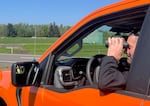
Nick Atwell uses binoculars in the bright orange PDX wildlife team truck. The binoculars are used for spotting birds during the daytime, while thermal detection helps in the dark.
Lillian Karabaic / OPB
One of those people is Nick Atwell, Senior Natural Resources & Wildlife Manager at Port of Portland. He’s part of a team of six biologists who work to keep birds and planes from crossing paths.
For this installment of “At Work With,” we rode along with him to learn what it‘s like to be an airport wildlife technician.
How do you describe your job to strangers?
“Dynamic.”
There’s so many different moving parts that Atwell struggles to describe the work succinctly.
The Port of Portland wildlife team patrols the runways in pairs daily from 5 a.m. to 9:30 p.m. They’re looking for any possible birds of concern and, if they find them, they use different tools to “haze” them.
“When we say hazing birds, we’re actually utilizing scare tactics to push birds out of the space that we would consider a high risk,” Atwell said.
“The technicians are out here all day long... it‘s every day of the year, no matter if it‘s holiday. So they’re always patrolling and actually taking action when warranted,” said Atwell.
From “hazing” birds to trapping and tagging birds of prey, to natural resources management along the airport’s floodplain — every part of the job serves the over-arching goal of reducing interactions between aviation and wildlife.
Their key metric is reducing “bird strike,” a bird hitting a plane. In 2024, the PDX airport had 62 reported bird strikes.
Atwell said keeping birds away from planes is hard work at the Portland International Airport in particular. “It‘s on the confluence of two major river systems and it‘s on the Pacific Flyway. So if you’re a migratory bird, the likelihood of you actually coming here is pretty high,” he said.
What kind of tools do you have?
The wildlife team has many tools — binoculars, traps, net guns, lasers, air cannons, pyrotechnics, night vision goggles.
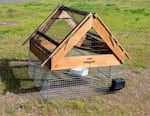
A large trap built by the wildlife team at the Portland International Airport. Small prey, such as a bird or mouse, will be placed inside the lower area of the trap the top will close on entry. Both the raptor and the prey bird are not harmed by the trap.
Lillian Karabaic / OPB
The high-powered green lasers are a bird deterrents.
Atwell says they sort of function as a light saber — “Birds have more green cones than mammalian species, so they see that green spectrum more than we would. So for you and I, we would only see the laser where it actually starts and where it terminates. But they see the whole tube much like a light saber, so they think it‘s going to hit them, and so that‘s why they flee,” he said.
There’s 30 radio-controlled sound cannons that are all strategically placed all throughout the 11,000 foot airfield. “They’re compressed propane gas that‘s ignited by a car battery that‘s solar charged,” said Atwell.
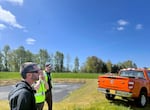
Next to the Portland International Airport runway, three members of the wildlife team monitor radio-controlled canons used to haze birds.
Lillian Karabaic / OPB
When the weather is colder, technicians use thermal imaging googles to spot birds in the dark. When it‘s light out, binoculars work fine.
Do you have any birds that get to stay at the airport?
“There’s six resident pairs out here. Those are the pairs that are here all the time. And well, we’d call [them] more airport-savvy. They’ve demonstrated the ability to navigate the airfield in a safe way,” said Atwell.

The wildlife team is always in contact with air traffic control at the Portland International Airport, pictured on April 16, 2025. Nick Atwell said the most crucial skills for this job are “multitasking and situational awareness. You need to be able to hear multiple different radios, cellphones, navigate in between aircraft, inside critical areas."
Lillian Karabaic / OPB
What kind of person is good at this job?
Atwell said the most crucial skills for this job are “multitasking and situational awareness. You need to be able to hear multiple different radios, cellphones, navigate in between aircraft, inside critical areas,” he said.
Even though the job is dynamic, Atwell cautions that wildlife technicians have to have a tolerance for office work, as there’s a lot of data collection. “It‘s such a unique job it‘s hard to know if it‘s for you until you experience it,” he said.
What do you do if a bird won’t move?
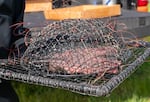
Nick Atwell holds one of the humane traps built by the wildlife team to capture raptors at the Portland International Airport. A small prey bird will be placed inside the trap, and a raptor's talons will get caught in the mesh. Both the raptor and the prey bird are not harmed by the trap.
Lillian Karabaic / OPB
If hazing tactics don’t work, sometimes the wildlife team will use humane traps. Their custom-built traps for raptors use small prey (like starlings or mice) as lures — but they aren’t harmed when a raptor is caught. “We even treat the prey well,” Atwell said.
Captured raptors are then tagged, banded and relocated away from the airport to a suitable area. For migratory birds, the wildlife team will drive them two to three hours away. “It always depends on the season... So we’re just trying to keep them kind of in line with their migratory patterns,” he said.
Atwell said that raptor relocation is his favorite part of the job. Each bird is measured and logged at pdxraptors.com.
Eager birders look for the special orange Port of Portland wing tags and report sightings. That data helps the wildlife team evaluate if the program is working.
The Port of Portland wildlife team has translocated 1,894 red-tailed hawks since 1999.
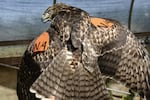
Bright orange Port of Portland wing tags are seen on a red-tailed hawk in this 2015 provided photo. Birders look for the wing tags and report sightings. That data helps the wildlife team evaluate if the program is working.
Port of Portland / Port of Portland
What‘s the worst part of the job?
The early wakeups and shift changes. The technicians start the morning shift at 5 a.m.
What‘s your most memorable capture?
“An injured bald eagle on West Hayden Island. A big-bodied bird,” said Atwell. “That was probably one of the more unique days.”
Out of all the high-tech gear available, a blanket was the key in this capture. “A blanket is a quality tool,” he said.

Nick Atwell, wildlife manager holds a captured red-tailed hawk at the Portland International Airport, in this provided 2015 photo. The PDX Wildlife Raptor Relocation program has translocated 1,894 red-tailed hawks since 1999.
Port of Portland
How do you proactively manage wildlife?
The job of keeping wildlife away starts years in advance if you know where to look. Even the trees on Northeast Airport Way are selected by the wildlife team to be unattractive to birds. “The upright branching structure ... that‘s decreasing the ability for birds to perch in,” said Atwell.
And the fluorescent green grass you see along the runway as you land? That‘s the wildlife team’s handiwork too. “That‘s the whole intent of the endophyte fescue variety is that geese do not like to eat it,” he said.

A storm water runoff pond at the Portland International Airport runway on April 16, 2025. One of the wildlife team's proactive wildlife management strategies is to hide storm water runoff ponds with thousands of black balls, like these, to hide the water from an aerial view.
Lillian Karabaic / OPB
They also try to hide any open water. Their storm water runoff ponds contain thousands of black balls to hide the water from an aerial view. “These balls float on top of the water. So instead of being this giant open water space … it‘s a proactive strategy," Atwell said.
Which birds are the biggest threat to aircraft?
“It‘s a risk assessment,” said Atwell. “It‘s how often are you struck here by aircraft at PDX? And then we couple that with the FAA national database how often are those birds causing damage throughout the country. And then we rank them. And so we come up with our birds of concern.”
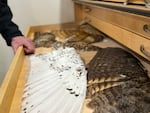
Nick Atwell shows preserved wings from bird strikes, which are used for education programs. When a bird strike does happen, the wildlife team collects DNA and other information in order to make mitigation decisions.
Lillian Karabaic / OPB
Were you a plane kid or a bird kid?
“I was a natural resources kid,” said Atwell.
How do you handle baby birds or nests on the airfield?
“We do have nests being built in areas that we would consider a higher risk,” said Atwell. “We would look to intervene with that prior to them being established...so they would nest offsite somewhere further away.”
“As far as birds that aren’t able to fly like adults and maybe their first flights.. we know where those nests are, and we would try to trap them as quickly as possible after their first flights and take them to what we call a flight cage that we have maintained over on Sauvie Island. So they learn to fly and hunt there instead of an airfield environment. From there, they’re translocated to a suitable site,” he said.
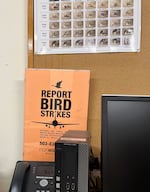
The wildlife team collects data on all bird strikes and encourages airport employees to report any strikes with signs like these around the Port of Portland. The data helps make habitat and aviation design decisions to prevent bird strike in the future.
Lillian Karabaic / OPB
“It depends on the success of the breeding season,” Atwell said, but usually a max of about six fledglings per year go to the flight cage on Sauvie Island.
What‘s the best part of the job?
The raptor relocation program. “It‘s very exciting when you pull a large bird of prey out of one of these traps,” Atwell said.
Are you always looking for birds, even when you’re not at work?
"I am,“ said Atwell, ”I also am seeing if they have bands on them. So I’m always looking real quick."

Nick Atwell stands in front of the collection of wildlife carriers in the Portland International Airport wildlife office on April 16, 2025. "They would also have some sort of cover on them. That's how you'd see this. And that's just to keep them totally calm until they're translocated." said Nick Atwell.
Lillian Karabaic / OPB
What kind of training or education do you need for this job?
Since Atwell started working at the Port of Portland in 1998, Airport Wildlife Technician has become a career with a specific credential from the Federal Aviation Administration.
In addition to a bachelor’s degree with “advanced botany,” it requires on-the-ground training, especially to learn the ins and outs of communicating with Air Traffic Control and understand runway lights and signals. “That‘s why I say this role is not just a biologist role, it‘s an aviation wildlife biologist role,” Atwell said.
“Everyone on my team has gone through the Mt. Hood Community College natural resources and wildlife program,” said Atwell. The Port of Portland takes on one wildlife intern each summer. “That is a great way to get your foot in the door and just to see what this work entails,” he said.
Portland is hosting the national conference for airport wildlife staff and interested students, Bird Strike USA, this August.
Is there a wildlife biologist at every airport?
At most large airports, there’s now a staff member doing similar work on preventing bird strike. “Often this is contracted out and that person that‘s responsible might have to go to multiple airports throughout the day, whereas we have a team that‘s here all day long, just PDX,” Atwell said.
Do you only worry about birds?
While avian wildlife is their biggest concern, there are a few mammals the wildlife team is concerned with as well.
“There’s a really robust population of coyotes here, and they do impact operations by crossing the runways, taxiways, that sort of thing,” said Atwell. The wildlife team tries to prevent coyotes by burying the perimeter fence- four feet deep and at a 45-degree angle so that the coyotes won’t be successful in digging.
Have you ever taken any of the wildlife home?
Yes, but not as a pet. Atwell has transported a few kestrels near his home for release. “I live in an area that it‘s suitable habitat and it‘s good translocation site,” he said.
Are there any wildlife that actually benefits from being near the airport?
“The streaked horned lark really likes really degraded habitat,” like sandy fields, said Atwell. As an interim conservation measure, the wildlife team keeps an undeveloped area near the airport “free of vegetation as a goose deterrent,” he said. The streaked horned lark is “a federally-listed species and protected underneath the Endangered Species Act,” said Atwell.
“And their numbers are declining all throughout the metropolitan area,” so Atwell said breaking up the vegetation in vacant lots can help provide an environment for them, and deter the higher-risk geese who prefer lush green fields.
Progressivepika asks: How much of the job is shooting Canada geese so they don’t get sucked into jet engines?
“If we’re doing everything that we should be and maintaining our airfield turf, it‘s not often,“ said Atwell. But, if they’re needed for human life and safety, rifles are ”locked up in a safe back in the office," he said.
